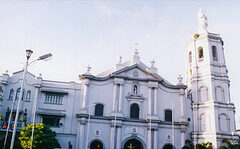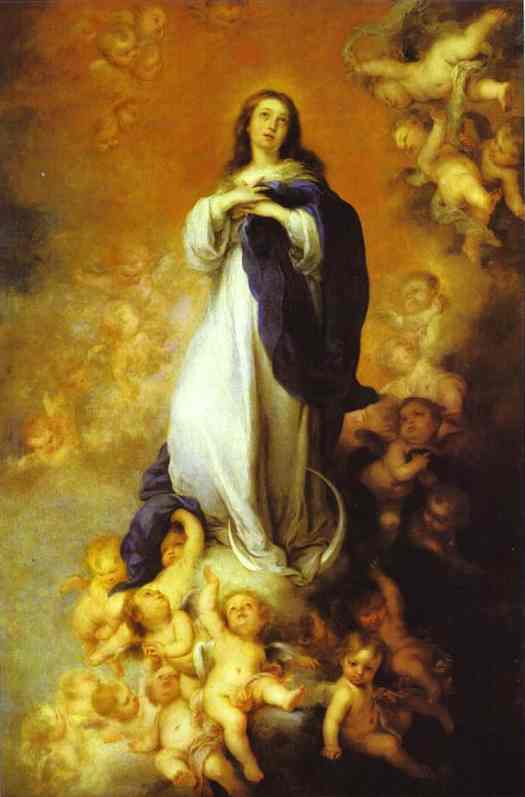Immaculate Conception Parish Cathedral-Minor Basilica
City of Malolos, Bulacan
The Parish
History

Malolos was Christianized on 1580 by the Augustinians and has been a focal point in the history of the country. The Parish Church of the Immaculate Conception had its beginnings with its first building in 1591 made of light materials. In succeeding years, it has been rebuilt and enlarged. The current church was consecrated in 1826 but was heavily damaged in the earthquakes of 1863 and 1880. These were renovated but was burned by the revolutionaries in 1898. Starting 2008, the church was heavily renovated that portions of the facade and interior were altered.

The facade is simple with touches of neo-classic. Doric columns divide it into three segments with the central part holding the statued niches, emblem of the Augustinians and the papal insignia.
The Cathedral was the seat of power of the President of the First Philippine Republic, Emilio Aguinaldo. When the Philippine-American War erupted in 1899, President Aguinaldo moved the capital from Malolos to San Fernando in Pampanga. The Cathedral was burned to delay the pursuing Americans. The Cathedral was rebuilt and, later, became the seat of the Bishop of the Diocese of Malolos.
Near the Cathedral is the equally important Barasoain Church, where the First Philippine Congress held sessions and drafted the 1898 Malolos Constitution.

The Diocese of Malolos
The Diocese of Malolos, with jurisdiction over the Province of Bulacan and the City of Valenzuela in Metropolitan Manila and suffragan to the Archdiocese of Manila, was created on March 11, 1962 by Pope John XXIII. Rev. Manuel del Rosario was installed Papal Nuncio Salvatore Siino as the first bishop of the Diocese.The current and 5th Bishop of Malolos is Most Rev. Jose F. Oliveros, D.D.
1. Vicariate of St. Didacus de Alcala - Valenzuela City
2. Vicariate of Our Lady of the Immaculate Conception - Malolos City, Bulacan
3. Vicariate of Our Lady of the Immaculate Conception - Santa Maria, Bulacan
4. Vicariate of St. Anne - Hagonoy, Bulacan
5. Vicariate of St. Augustine - Baliuag, Bulacan
6. Vicariate of St. Fransis of Assisi - Meycauayan City, Bulacan
7. Vicariate of St. James the Apostle - Plaridel, Bulacan
8. Vicariate of St. Martin the Tours - Bocaue, Bulacan
9. Vicariate of St. Michael the Archangel - San Miguel, Bulacan
The Patroness

The Immaculate Conception was solemnly defined as a dogma by Pope Pius IX in his constitution Ineffabilis Deus on 8 December 1854. The Catholic Church believes that the dogma is supported by Scripture (e.g., Mary's being greeted by the Angel Gabriel as "full of grace") as well as either directly or indirectly by the writings of Church Fathers such as Irenaeus of Lyons and Ambrose of Milan. Catholic theology maintains that since Jesus became incarnate of the Virgin Mary, it was fitting that she be completely free of sin for expressing her fiat. The Pope stressed that Mary's sinlessness was not due to her own merits, but truly, by the merits of her son, Jesus.
"We declare, pronounce and define that the doctrine which holds that the Blessed Virgin Mary, at the first instant of her conception, by a singular privilege and grace of the Omnipotent God, in virtue of the merits of Jesus Christ, the Saviour of mankind, was preserved immaculate from all stain of original sin, has been revealed by God, and therefore should firmly and constantly be believed by all the faithful."
Simply stated, Mary possessed sanctifying grace from the first instant of her existence and was free from the lack of grace caused by the "original or first sin" at the beginning of human history.
Explanation of the Dogma
In Catholic teachings the dogma is explained as follows:
1. The essence of original sin consists formally in the lack of sanctifying grace. Being preserved from original sin, Mary entered existence in a state of sanctifying grace.
2. Mary's freedom from original sin was an unmerited gift of God's grace.
3. The efficient cause of the Immaculate Conception was Almighty God.
4. The meritorious cause was the Redemption by Jesus Christ. It follows from this that even Mary was in need of redemption and was, in fact, redeemed "by the grace of Christ" in a more perfect way than other human beings. Christ's redemption frees all humanity from original sin. The uniqueness of what Christ has done for Mary is that she was freed from original sin before ever inheriting it, while the rest of humanity is freed after it has been inherited from Adam and Eve. Thus, this dogma in no way contradicts the dogma that all children of Adam are subject to original sin and in need of a savior.
5. The final cause of the Immaculate Conception is her Motherhood of God.
In his Apostolic Constitution Ineffabilis Deus (8 December 1854), which officially defined the Immaculate Conception as dogma for the Roman Catholic Church, Pope Pius IX primarily appealed to the text of Genesis 3:15, where the serpent was told by God, "I will put enmity between you and the woman, between your seed and her seed". According to the Roman Catholic understanding, this was a prophecy that foretold of a "woman" who would always be at enmity with the serpent—that is, a woman who would never be under the power of sin, nor in bondage to the serpent. Some Roman Catholic theologians have also claimed the angel Gabriel's salutation to Mary at the Annunciation (Luke 1:28) as scriptural evidence for the Immaculate Conception. The verse "Thou art all fair, my love; there is no spot in thee", "Tota pulchra es, amica mea, et macula non est in te" (Vulgate), from the Song of Solomon (4.7) was also regarded as a scriptural confirmation of the doctrine, and as "macula" is Latin for "spot" or "stain", is probably responsible for its name.
The early Church Fathers compared Mary to Eve. St. Justin Martyr said that Mary was a kind of New Eve, "in order that the disobedience which proceeded from the serpent might receive its destruction in the same manner in which it derived its origin". (Dialogue with Trypho, 100) Tertullian argued in a similar manner: "As Eve had believed the serpent, so Mary believed the angel. The delinquency which the one occasioned by believing, the other by believing effaced". (On the Flesh of Christ, 17) St. Irenaeus declared that Mary became "the cause of salvation, both to herself and the whole human race", because "what the virgin Eve had bound fast through unbelief, this did the virgin Mary set free through faith". (Against Heresies, Book III, cap. 22, 4) St. Jerome coined the phrase, "Death came through Eve, but life has come through Mary", (Letter XXII, To Eustochium, 21). This may well be inspired by the original explanation in the Bible, in Romans chapter 5, that while death came through one man (Adam), life and grace have been brought through one man (Jesus Christ).
The Catholic Encyclopedia of 1907, however, states that these scriptures merely serve as corroborative evidence assuming that the dogma is already well established, and that there is insufficient evidence to prove the dogma to someone basing their beliefs solely on biblical interpretation:
No direct or categorical and stringent proof of the dogma can be brought forward from Scripture. ... The Proto-evangelium [Genesis 3:15], therefore, in the original text contains a direct promise of the Redeemer, and...the perfect preservation of His virginal Mother from original sin. The salutation of the angel Gabriel—chaire kecharitomene, Hail, full of grace...finds its explanation only in the Immaculate Conception of Mary. But the term kecharitomene (full of grace) serves only as an illustration, not as a proof of the dogma.
Other verses sometimes used to defend the Immaculate Conception include:
"And you shall make the ark of testimony of incorruptible wood, and you shall gild it with pure gold, you shall gild it within and without; and you shall make for it golden wreaths twisted round about." (Exodus 25:10-11 Brenton LXX)
"So I made an ark of boards of incorruptible wood, and I hewed tables of stone like the first, and I went up to the mountain, and the two tables were in my hand." (Deuteronomy 10:3 Brenton LXX)
Other translations use the words "setim", "acacia", "indestructible", and "hard" to describe the wood used. In any case, Moses used this wood because it was regarded as very durable and "incorruptible". Mary is regarded by Catholic and Orthodox Christians as being the Ark of the Covenant in the New Testament and therefore claim it is fitting that the New Ark likewise be made "incorruptible" or "immaculate". Their basis for calling the Virgin Mary the Ark of the Covenant is based partly on the parallels of the Ark in Second Samuel 6 with the Nativity narrative of the Gospel of Luke. The early Church Fathers called Christ, the Church, and the Virgin Mary each at one point as being symbolized by the Ark.
It is also claimed that Mary is shown as being totally faithful to Christ, especially during his Passion, when he was abandoned by his followers and apostles except for the young John. In this way, Mary's complete faithfulness is argued to be the fruit of being sinless, as she could not then reject Christ in the darkest hour.
Baranggays under the Parish of the Immaculate Conception
|
|
|
|
|
ATLAG Titular Patron: San Antonio de Padua |
CALERO Titular Patron: Santa Cruz |
CANALATE Titular Patron: San Ildefonso de Toledo |
|
|
|
|
|
CANIOGAN Titular Patron: Santa Maria Salome |
SAN JUAN Titular Patron: San Juan Bautista |
SAN VICENTE Titular Patron: San Vicente Ferrer |
|
|
|
|
|
Santiago Titular Patron: San Santiago Apostol |
Sto. Cristo Titular Patron: Santo Cristo |
Sto. Rosario Titular Patron: Nstra.Sñra. del Rosario |
|
|
|
|
STO. NINO Titular Patron: Santo Niño de Malolos |
SABITAN Titular Patron: Jesus Resucitado |
The Team Ministry

Most Rev. Jose Francisco Oliveros, DD
Born: September 11, 1946 in Quezon, Quezon
Ordained Priest: November 28, 1970
Consecrated Bishop: March 20, 2000
Appointed Apostolic Administrator: Diocese of Malolos: August 15, 2003
The current bishop is a priest from the Diocese of Boac in Marinduque, Most Rev. Jose Francisco Oliveros, DD. He took the office on May 14, 2004. He is the current Moderator of the Parish's Team Ministry.

Rev. Msgr. Jaime S. Garcia - Rector of the Parish
Msgr. Garcia previously served as parish priest in the Immaculate Conception Parish in Sta. Maria, Bulacan. He is an appointed member of the Diocesan Advisory Board and is the current Director of the Apostolado ng Panalangin in the Diocese of Malolos.
Members of the Team Ministry
|
|
|
| Rev. Fr. Renato Brion Jr. | Rev. Fr. Conrado Santos |












